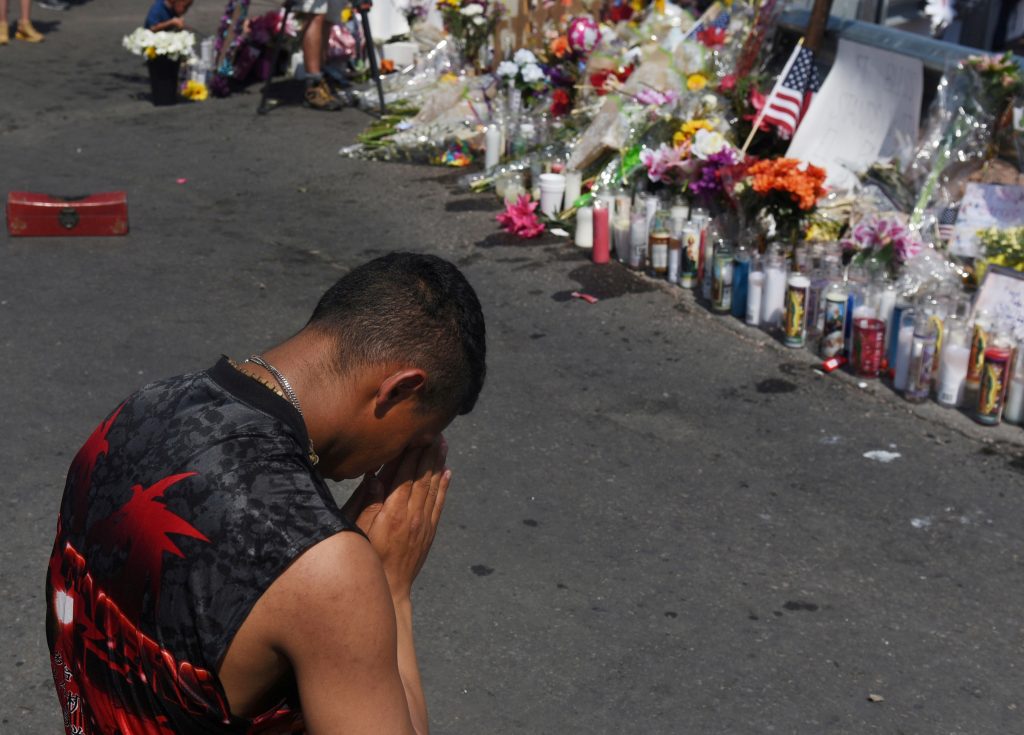Ever since 21-year-old white supremacist Patrick Crusius of Allen, Texas, grabbed a high-powered rifle and drove 10 hours to El Paso last Saturday to live out a nativist manifesto that warned of an “invasion” and called immigration “detrimental to the future of America,” I’ve been thinking about borders.
There is the nearly 2,000-mile U.S.-Mexico border on which El Paso sits and over which President Trump promised to build a big, beautiful wall, courtesy of Mexico. In the last five years, the people who cross that border, either illegally in search of jobs, or as refugees asking for asylum, have been less likely to be from Mexico than from Honduras, Guatemala, or El Salvador.
Crusius worried that so many people were coming across that physical border that Texas was becoming a Mexican state, a place where the official language would become Spanish and whites would be pushed around and finally pushed aside. Sociologists call this phenomenon “cultural displacement,” and the shooter was absolutely terrified of it.
But there is also the invisible border between sanity and madness; one would think that Crusius crossed that line the minute he hatched his plan to — as he later told police — “kill as many Mexicans as possible,” teasing many of them as they ran in horror away from the Walmart Supercenter at the Cielo Vista Mall on the west side of El Paso. According to survivors, as screaming women and children scurried by, the shooter would playfully shout at them: “I’m going to get you!” If that’s not madness, what is?
Crusius “got” many of them. In the end, 22 people died and 24 were injured. The dead included Mexican nationals, who had come north to go shopping, and whose families in Mexico are now shopping for coffins. Most of the nearly 50 people hurt or killed in El Paso were Mexican-American; the deceased had names like Marquez, Garcia, Sanchez, and Anchondo. This was no coincidence. This was a poor man’s attempt at ethnic cleansing.
There’s also the border between fantasy and reality. Fantasy is where some Trump supporters spin frantically in trying to suggest that the president had nothing to do with the massacre. Reality is the record. Ever since the real estate mogul launched his White House bid in June 2015 by likening Mexican immigrants to rapists and drug traffickers, this community has been his piñata. Some of my fellow Mexican-Americans have been telling me for several months that they feared something like this was bound to happen. And now it has.
Finally, there’s the geographic border that Crusius had to cross in the state of Texas as he drove from where he lived to where he wanted to go to complete his mission. He lived in an overwhelmingly white suburb of Dallas, where the well-to-do hide away in their gated community from what they consider the dangerous and seedy aspects of urban life. Living in that bubble, far away from people who looked and thought different than he did, was not helpful.
He probably played video games, retreating into virtual reality as he lived his own virtual reality completely walled off from real life. The mission at hand required that he scale those walls that surrounded him and go to a different place, a multicultural city where the hunting would be better, a border city where 80 percent of residents are Mexican or Mexican-American.
He crossed that kind of border, that invisible line, sometime during the trek of 650 miles. Along the way, he must have passed plenty of department stores. He could have stopped at any one of them and started his shooting spree. But apparently, he was saving his rage and his bullets for the people of El Paso.
In crossing that border, Crusius was leaving behind the white world and entering the Mexican one. He was going from the modern to the ancient, from manicured suburbs filled with 4,000-square-feet “McMansions” to the towns and neighborhoods that produce the hardworking people who do the manicuring.
With every mile that he drove toward the U.S.-Mexico border, the assailant was getting closer to what might as well have been another planet, one that had a darker complexion, a stronger devotion to Catholicism, healthier family ties, more respect for the elderly, and a longer memory.
In the suburbs, nothing is permanent; strawberry fields give way to rows of new houses in the blink of an eye. But on the border, one cannot escape the reassuring feeling that horizons and landscapes will never change.
The suburbs never remember. The border never forgets.
Just like the people of the border city of El Paso will never forget the atrocity that was done to them, who did it and why, and — last but not least — who and what set it all in motion.
Ruben Navarrette, a contributing editor to Angelus, is a syndicated columnist with The Washington Post Writers Group, a member of the USA Today Board of Contributors, a Daily Beast columnist, author of “A Darker Shade of Crimson: Odyssey of a Harvard Chicano,” and host of the podcast “Navarrette Nation.”
Start your day with Always Forward, our award-winning e-newsletter. Get this smart, handpicked selection of the day’s top news, analysis, and opinion, delivered to your inbox. Sign up absolutely free today!

